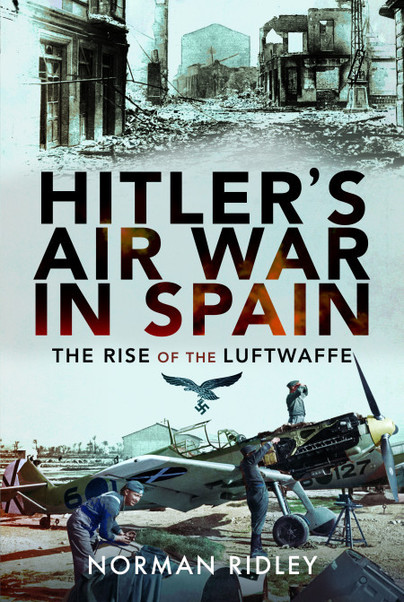Author Guest Post: Norman Ridley
Mission Creep in the Spanish Civil War
When the German businessman Johannes Bernhardt landed at Gatow airfield in the outskirts of Berlin on 25 July 1936, Hans-Heinrich Dieckhoff, Director of the Nazi Party’s Political Section, under instructions from Luftwaffe chief Hermann Göring, was determined to prevent him getting access to Adolf Hitler who was enjoying the Wagner Festival at Beyreuth. He knew that Bernhardt had flown in from Spain and he didn’t know exactly what he wanted but he suspected that it was not something that his boss, Göring, wanted to hear. Bernhardt had already tried and failed to broker a deal for General Franco to buy a number of Junkers Ju-52 transport aircraft from the Luftwaffe but Göring, despite Germany’s desperate need of foreign currency, was unwilling to risk getting involved with this shady customer in the context of Spanish politics that was on the verge of boiling over into civil war. Hitler, he feared might have no such qualms. There was no knowing what he might decide to do while wallowing in the emotional landscape of Wagnerian drama.
Bernhardt had come this time with a personal handwritten request for help from Franco that he was eager to place into Hitler’s hands. Franco, along with other Spanish generals had staged a coup d’état against the Spanish Republican government but Franco had somehow managed to find his best troops stranded in Morocco and unable to get safely across the Straits of Gibraltar to take part in the revolt. Without them, the insurrection would fail just like the ones before.
As was often the case with Nazi administration, there was fierce competition between different factions who spent much time battling each other. As it happened, Hitler’s number two, Rudolf Hess, saw an opportunity to put one over his arch rival Göring. Through his contacts in the Party, Bernhardt was able to contact Hess who immediately whisked Bernhardt away from Berlin and with a coterie of Hess’s high-level officials headed for the Villa Wahnfried, Hitler’s private residence at Beyreuth. Hess waited until Hitler had returned from a particularly invigorating performance of Die Walküre then introduced Bernhardt who was able to deliver his letter.
As it happened, Hitler had been following events in Spain very closely. He knew that Mussolini had already sent aircraft and troops to support Franco but he had little regard for Italian military capabilities and spent more than an hour explaining to Bernhardt why Franco’s rebellion was bound to fail. Hitler was not exactly turning him down but, all in all, his response did not comfort Bernhardt who listening in silence. Hitler then invited Göring and Army chief General Werner von Blomberg to join them from an adjoining room. Hitler looked away thoughtfully in a moment of quiet, undisturbed by the endless sound his own voice. Göring entered with his usual beaming smile. Blomberg, like many of his Prussian Junkers pals, was not an opera fan and looked tired. They waited. Then Hitler turned and, to Bernhardt’s amazement informed the room that he would agree to Franco’s request and send 10 transport aircraft to ferry his men across the Straits.
Blomberg expected nothing less from Hitler than this nonsense but Göring lost the smile and spluttered objections. The Spanish are primitives, their pilots will crash whatever aircraft we send. Franco will be left stuck in Morocco and he will lose the war and we will not get paid. There will be an international outcry against Germany. Hitler waved away these thoughts. We can send out own pilots, he said, the aircraft will not crash. Franco will win. He knew that Spain’s national bank was sitting on a massive amount of gold that the country had accumulated by trading with both sides during the First World War. Payment would not be a problem.
Sending German pilots to fly in a war zone was not Göring’s idea of a good idea even if they were not flying combat aircraft. How would they be expected to defend themselves if attacked? The Spanish government has nothing to attack them with, Hitler said, they would be in and out in a few weeks and when Franco won the war, which he was sure to do if he could get his Moroccan troops to Madrid quickly, he would be more than willing to increasing trade with Germany in the steel-hardening wolfram minerals which at the moment were all going to Britain. Göring knew when Hitler made up his mind it stayed made up. He now turned about-face and expressed his wholehearted support for sending aircraft and crews with the proviso that German involvement remained a closely guarded secret and the Ju-52 crews were to avoid contact with the enemy at all costs.
With a title chosen by Hitler himself, Operation Magic Fire was under way with Major Alexander von Scheele in command. On the next day, pilots of I./JG 132 at Döberitz were asked to volunteer for a special mission. The chosen few then resigned their commissions and disappeared from their unit overnight. Bernhardt set up a company, HISMA, in Madrid to handle the Spanish side and by 31 July, five days after the Beyreuth meeting, the SS Usaramo was loaded up in Hamburg with 85 German technicians, 10 Ju-52s and 6 Heinkel HE-51s, anti-aircraft guns, bombs and ammunition. Despite what Hitler had said, there was no way the Germans were sending their people and equipment into a war zone without adequate protection. At the same time another 10 Ju-52s were already on their way to Morocco under their own power. When they arrived, they immediately started the airlift of troops but a few Ju-52s were handed over to Spanish forces despite Spanish pilots having great difficulty in handling them. Von Scheele wondered how many aircraft he was going to lose. Things got worse. Soon the airlift started attracting the attention of Republican warships patrolling the Straits of Gibraltar and the transports came under fire.
Von Scheele wasted no time in authorising his pilots to return fire and on 13 August two Ju-52s that had been hurriedly converted to carry bombs attacked the Spanish battleship Jaime I outside Malaga harbour, killing 47 crewmen, to prevent it moving out to attack the transports. Von Scheele knew that Berlin could not criticise him for protecting his men but he was urged to restrain them from further offensive action.
Italian air crews who had been in action in support of the rebels for some weeks had no such qualms. They attacked Republican aircraft and airfields at will and the German pilots eagerly pestered von Scheele to let them join in the action confident that their superior aircraft and their own prowess would guarantee easy pickings with low risk. There seemed no harm in giving his airmen a little combat experience.
German pilots claimed their first victim on 25 August when Oberleutnant Kraft Eberhardt shot down an ancient Breguet XIX biplane over Comenar at around the same time that 27 nations including Germany, Italy and the Soviet Union signed a non-intervention agreement. Before the ink was dry, however, On 28 August Hitler officially authorised involvement of German forces in Spain and very soon many more aircraft were on their way to Spain.

Order your copy of Hitler’s Air War in Spain here.

